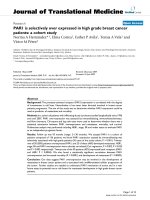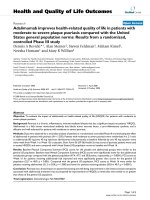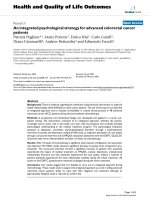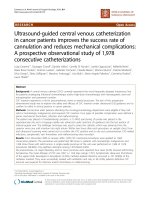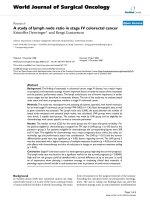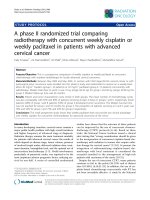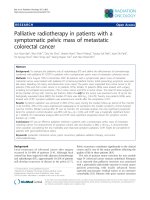TRIBE-2: A phase III, randomized, openlabel, strategy trial in unresectable metastatic colorectal cancer patients by the GONO group
Bạn đang xem bản rút gọn của tài liệu. Xem và tải ngay bản đầy đủ của tài liệu tại đây (626 KB, 8 trang )
Cremolini et al. BMC Cancer (2017) 17:408
DOI 10.1186/s12885-017-3360-z
STUDY PROTOCOL
Open Access
TRIBE-2: a phase III, randomized, openlabel, strategy trial in unresectable
metastatic colorectal cancer patients by the
GONO group
Chiara Cremolini1†, Federica Marmorino1†, Fotios Loupakis1, Gianluca Masi1, Carlotta Antoniotti1, Lisa Salvatore1,
Marta Schirripa1, Luca Boni2, Vittorina Zagonel3, Sara Lonardi3, Giuseppe Aprile4, Emiliano Tamburini5,
Vincenzo Ricci6, Monica Ronzoni7, Filippo Pietrantonio8, Chiara Valsuani9, Gianluca Tomasello10,
Alessandro Passardi11, Giacomo Allegrini12, Samantha Di Donato13, Daniele Santini14, Alfredo Falcone1*
and on behalf of all the investigators of the Gruppo Oncologico del Nord Ovest
Abstract
Background: Chemotherapy plus bevacizumab is a standard first-line treatment for unresectable metastatic
colorectal cancer patients. Different chemotherapy backbones may be chosen, including one to three drugs, based
on patients’ general conditions and comorbidities, treatments’ objectives, and disease characteristics. TRIBE trial
demonstrated a significant advantage in terms of progression-free survival and overall survival for FOLFOXIRI plus
bevacizumab as compared with FOLFIRI plus bevacizumab. Based on recent evidence, the de-intensification of the
upfront regimen after 4–6 months of treatment is nowadays regarded as a valuable option. Moreover, the
prolonged inhibition of angiogenesis, and in particular the continuation of bevacizumab beyond the evidence of
disease progression, is an efficacious strategy in the treatment of metastatic colorectal cancer patients.
Methods/design: TRIBE-2 is a prospective, open-label, multicentric phase III randomized trial in which unresectable
and previously untreated metastatic colorectal cancer patients are randomized to receive first-line FOLFOX plus
bevacizumab followed by FOLFIRI plus bevacizumab after disease progression or FOLFOXIRI plus bevacizumab
followed by the re-introduction of the same regimen after disease progression. The primary endpoint is to compare
the efficacy of the two proposed treatment strategies in terms of Progression Free Survival 2.
Discussion: The TRIBE-2 study aims at answering the question whether the upfront use of FOLFOXIRI improves the
clinical outcome of metastatic colorectal cancer patients, when compared with the pre-planned, sequential use of
oxaliplatin-based and irinotecan-based doublets. Both proposed treatment strategies are designed to exploit the
effectiveness of the prolonged inhibition of angiogenesis, alternating short (up to 4 months) induction periods and
less intensive maintenance phases.
Trial registration: TRIBE2 is registered at Clinicaltrials.gov: NCT02339116. January 12, 2015. TRIBE-2 is registered at
EUDRACT 2014–004436-19, October 10, 2014.
Keywords: Colorectal cancer, Bevacizumab, Strategy, Folfoxiri, Clinical trial
* Correspondence:
†
Equal contributors
1
Dipartimento di Ricerca Traslazionale e delle Nuove Tecnologie in Medicina
e Chirurgia, Oncologia Medica 2 Universitaria, Azienda
Ospedaliero-Universitaria Pisana, Via Roma 67, 56126 Pisa, Italy
Full list of author information is available at the end of the article
© The Author(s). 2017 Open Access This article is distributed under the terms of the Creative Commons Attribution 4.0
International License ( which permits unrestricted use, distribution, and
reproduction in any medium, provided you give appropriate credit to the original author(s) and the source, provide a link to
the Creative Commons license, and indicate if changes were made. The Creative Commons Public Domain Dedication waiver
( applies to the data made available in this article, unless otherwise stated.
Cremolini et al. BMC Cancer (2017) 17:408
Background
FOLFOXIRI plus bevacizumab as first-line treatment of
unresectable mCRC
The first-line treatment is a crucial starting point in the
therapeutic route of every metastatic colorectal cancer
(mCRC) patients [1]. The strategic value of this choice
lies in the importance of obtaining disease control, preventing disease progression and achieving symptoms’ relief. Moreover, the first-line treatment allows pursuing
the unique chance of cure for a percentage of patients,
and exploiting subsequent interventions, in terms of
both surgical/locoregional approaches and other systemic treatments. In the last few years, many therapeutic
associations emerged as possible options and the selection of the most appropriate treatment is a challenging
issue for medical oncologists.
Recent evidences demonstrate that the intensity of
chemotherapy can be modulated: traditional oxaliplatin
or irinotecan-based doublets [2, 3] can be de-potentiated
in fluoropyrimidine monotherapy [4, 5] or intensified in
the triple regimen FOLFOXIRI (5-FU, oxaliplatin and
irinotecan) [6, 7].
In particular, the phase III randomized TRIBE study [6]
strengthened the use of FOLFOXIRI plus bevacizumab
(bev) as a new option for the upfront treatment of mCRC
patients who meet inclusion criteria of the study. This
multicenter trial included 508 patients with unresectable
mCRC to compare FOLFOXIRI plus bev with FOLFIRI
plus bev. Patients received up to 12 cycles of induction
treatment, followed by maintenance therapy with 5-FU/
LV (5-fluorouracil/leucovorin) and bev until disease progression. The trial met its primary endpoint progression
free survival (PFS). Indeed, the triplet plus bev provided a
significant advantage in terms of PFS as compared with
FOLFIRI (folinic-acid, 5-Fluorouracil, irinotecan) plus bev
(median PFS: 12.1 months versus 9.7 months, HR 0.75,
95% CI 0.62–0.90; P = 0.003). After an extended median
follow-up period of 48.1 months, updated results demonstrated a significant advantage also in terms of overall survival (OS) (median OS: 29.8 months versus 25.8 months;
HR 0.80, 95% CI 0.65–0.98; P = 0.030). Subgroup analyses
evidenced no significant interaction between treatment
effect and baseline clinical characteristics or RAS and
BRAF molecular status [8].
Second and further lines of treatment were chosen by investigators. The 76% of patients in both arms were exposed
to second-line treatments and around 80% of patients in
the experimental arm received again a fluoropyrimidine +/− oxaliplatin +/− irinotecan as part of their
second-line therapy. Of note, while induction treatments were administered up to 6 months, the median
PFS in the FOLFOXIRI plus bev group was longer than
12 months, so that the median duration of oxaliplatinand irinotecan-free intervals was around 6 months.
Page 2 of 8
Maintenance therapy after chemotherapy plus
bevacizumab
The optimal duration of chemotherapy and bev is still a
matter of debate [9–11]. Results from recent randomized
studies showed that the de-intensification of the chemotherapy backbone while continuing the antiangiogenic is
an efficacious strategy. Maintenance allows to delay progression, thus prolonging the time interval between the
completion of the induction treatment and the evidence
of disease progression. These longer “full chemotherapy”-free intervals make more clinically and biologically
sound the reintroduction of agents used during the induction phase after the occurrence of progression.
Three studies compared maintenance strategies following chemotherapy plus bev with clinical observation.
SAKK 41/06 [12] was a non-inferiority trial that randomized patients that did not progress after 4–6 months of
XELOX (capecitabine/oxaliplatin) or FOLFOX (folinicacid, 5-Fluorouracil, oxaliplatin) plus bev, to continue or
not bev alone until disease progression. The non-inferiority
of the observation strategy was not demonstrated in terms
of both time to progression (TTP) and OS.
In the CAIRO-3 trial [13], patients achieving disease
stabilization or response after six cycles of CAPOX (capecitabine/oxaliplatin) plus bev were randomized between
observation and maintenance treatment with “low dose”
capecitabine plus bev. After the first disease progression,
CAPOX plus bev had to be reintroduced and continued
until the second evidence of disease progression. The
primary endpoint was PFS2, defined as the time from
randomization to progression upon re-introduction of
CAPOX plus bev. Patients in the maintenance arm
achieved a significant benefit in terms of PFS2, PFS and
a non-significant advantage in OS.
Finally, AIO KRK 0207 study [14] investigated whether
treatment discontinuation or continuation with bev alone
was non-inferior to maintenance with fluoropyrimidine/
bev, in mCRC patients who had received 24 weeks of an
oxaliplatin-based doublet. At first progression, re-induction
of the initial treatment was planned. The primary endpoint
was time to failure of strategy (TFS). Results from this trial
showed that bev monotherapy was not inferior to a fluoropyrimidine plus bev as maintenance, while the noninferiority was not demonstrated for the observation strategy in terms of TFS. At the time of data analysis, OS results
were extremely immature.
On the basis of these evidences, the opportunity to alternate induction and maintenance phases in the disease
history of mCRC patients is nowadays a valuable option.
Continuation of bevacizumab beyond progression in mCRC
More than 10 years ago, preclinical evidence led to
hypothesize that continuing antiangiogenic treatments
Cremolini et al. BMC Cancer (2017) 17:408
beyond the occurrence of resistance could be efficacious
in mCRC. Results from the observational studies BRiTE
[15] and ARIES [16] provided initial clinical data supporting this suggestion.
The prospective confirmation of the effectiveness of
the prolonged inhibition of angiogenesis was provided
by the phase III ML18147 [17] and BEBYP trials [18].
ML18147 study [17], conducted in Europe and Saudi
Arabia, randomIzed mCRC patients previously treated
with bev plus a first-line doublet to the switched doublet
with or without bev. Eligible patients were those who
had experienced progressive disease up to 3 months
after discontinuing first-line bev plus chemotherapy. The
use of bev beyond progression provided a significant
advantage in terms of OS, primary endpoint, (11.2 vs
9.8 months, HR: 0.81 [0.69–0.94], p = 0.0062) and PFS
(5.7 vs 4.1 months, HR: 0.68 [0.59–0.78], p < 0.0001).
BEBYP trial [18], contemporaneously conducted in Italy
and prematurely stopped when results from ML18147 were
released, had a similar design. This study evaluated the reintroduction of bev even in patients who had completed
the first line treatment more than 3 months before disease
progression to first-line. The continuation of bev beyond
progression provided significant benefit in terms of PFS,
primary endpoint, (6.8 vs 5.0 months, HR: 0.72 [0.54–0.97],
p = 0.0029), while no statistically significant differences in
OS (14.1 vs 15.5 months, HR: 0.77 [0.56–1.07], p = 0.12)
were reported. Nevertheless, the trial was clearly underpowered to detect an advantage in terms of survival. The benefit
in PFS in favor of the continuation of bev was observed in
all analyzed subgroups and in particular both in patients
who discontinued bev for more or less than 3 months.
Based on these data, the continuation of bev beyond
progression is an efficacious option in the treatment of
mCRC patients.
Drawing from these evidences the phase III TRIBE-2
study was designed in order to compare two first- and
second-line strategies, aiming at exploiting the effectiveness of a prolonged inhibition of angiogenesis. A
Fig. 1 Study treatment
Page 3 of 8
standard strategy of an upfront doublet (FOLFOX) plus
bev followed by a switched doublet (FOLFIRI) plus bev
after disease progression is compared to a strategy of upfront FOLFOXIRI plus bev then followed by reintroduction of FOLFOXIRI plus bev after disease progression.
All combination treatments are repeated up to 8 cycles
and followed by maintenance with a fluoropyrimidine
plus bev, in order to shorten the duration of more intensive treatments and to prolong as more as possible oxaliplatin- and irinotecan-free intervals.
Methods/design
Study treatment
This is a prospective, open-label, multicentric phase III
randomized trial in which initially unresectable and
previously untreated mCRC patients are randomized to
receive two different strategies: first-line FOLFOX plus
bev followed by FOLFIRI plus bev after disease progression (arm A, standard treatment) or first-line FOLFOXIRI plus bev followed by reintroduction of FOLFOXIRI
plus bev after disease progression (arm B, experimental
strategy). All treatments are administrated up to 8 cycles
followed by 5-FU/LV plus bev maintenance until disease
progression, unacceptable adverse events, or consent
withdrawal (Fig. 1).
In the case of surgical radical resection of residual metastases, post-operative therapy with the same preoperative regimen is planned up to an overall duration of
6 months (12 cycles), then followed by 5FU/LV plus bev
up to 6 months after resection. This choice lies on the rationale that, though in the absence of a formal demonstration, it might be reasonable that if a regimen has allowed
to pursue secondary resection in a specific patient, it will
be also effective in preventing disease relapse (Fig. 2).
Study objectives and endpoints
TRIBE-2 study aims at comparing the efficacy of the two
proposed treatment strategies: the upfront use of the
triplet plus bev followed by the reintroduction of the
Cremolini et al. BMC Cancer (2017) 17:408
Page 4 of 8
Fig. 2 Recommended post-operative treatment in the case of radical resection of metastases
same regimen at disease progression or the sequential
use of oxaliplatin-based and irinotecan-based doublets,
combined with the antiangiogenic.
The primary endpoint of this trial is Progression Free
Survival 2 (PFS2), beginning with randomization and
ending with the first of the following events: a) death; b)
disease progression on any treatment given after 1st progression.. Disease status will be evaluated according to
RECIST 1.1 criteria [19]. The determination of disease
progression will be based on investigator-reported measurements and a subsequent central revision is planned.
For patients that will not receive any treatment within
3 months after 1st progression, PFS2 will be equal to
PFS, since in these patients the proposed treatment
strategy has failed; on the other hand, if following a
RECIST but clinically irrelevant disease progression, investigators decide to wait until the subsequent disease
assessment and the time interval is <3 months, this is
accepted as part of the strategy.
Secondary objectives of this study are to compare the
two proposed treatment strategies in terms of: PFS, 2ndPFS,time to failure of strategy, OS, response rate, rate of
secondary R0 resection of metastases, safety profile.
2nd-PFS is defined as the time from the start of the
second-line treatment to the evidence of disease progression or death from any cause, whichever occurs first.
TFS is defined as the time from randomization to the
first of the following events: death, introduction of a
new drug (a drug that was not included in the original
strategy), evidence of disease progression during treatment with all the drugs of the initial strategy.
Statistical design
Based on the assumption that PFS2 of each arm follows
an exponential distribution and hypothesizing a true HR
for PFS2 of 0.77 between the experimental and the
control group, 466 events are required for a two-sided
unstratified log-rank test to have 80% power with
α = 0.05. Assuming a proportion of PFS2 equal to 50%
at 15 months in arm A, this treatment effect can be
translated to a 9% absolute improvement in PFS2 at
15 months in arm B. With an accrual rate of 200 subjects/year, a minimum follow up period equal to 1.5 years
and an overall dropout rate of 5%, it is required to enroll
654 subjects, randomized in a 1:1 ratio.
A group sequential design with one interim analysis is
planned. The analyses will take place at 2/3 (303 events)
of the events for the primary endpoint, using an O’Brien
Fleming alpha-spending rule. The interim analysis will
assess the superiority of the experimental arm versus the
control group for the primary endpoint: the study will
be considered for early termination only if superiority is
met. The first interim analysis will have a two-sided
alpha level of 0.0131. According to the O’Brien Fleming
spending rule this will leave a two-sided alpha level of
0.0455 for the final analysis. Therefore, the total type I
error rate will be only slightly increased.
Study population
As in previous trials by the GONO group (Table 1) investigating the use of the triplet, only patients between
18 and 75 years old are eligible. Those between 71 and
75 years old are included only if their ECOG performance status is 0. Main eligibility criteria include measurable disease according to RECIST version 1.1 [19],
adequate bone marrow, liver, and renal function, no previous exposure to an oxaliplatin-containing adjuvant
therapy. Previous adjuvant chemotherapy with fluoropyrimidines alone is allowed if more than 6 months have
elapsed between the end of the adjuvant therapy and
Cremolini et al. BMC Cancer (2017) 17:408
Page 5 of 8
Table 1 TRIBE-2 participating centers
Principal Investigator
Site Name
City
Sergio Bracarda
Ospedale San Donato
Arezzo
Angela Buonadonna
Centro di Riferimento Oncologico
Aviano
Nicola Silvastris
IRCCS BARI
Bari
Stefania Mosconi
A.O. Papa Giovanni XXIII
Bergamo
Alberto Zaniboni
Fondazione Poliambulanza Istituto Ospedaliero
Brescia
Saverio Cinieri
Ospedale “SENATORE A. PERRINO”
Brindisi
Andrea Mambrini
A.S.L. 1 Massa Carrara
Carrara
Roberto Bordonaro
A.O.R.N.A.S. Garibaldi
Catania
Gianluca Tomasello
Istituti Ospitalieri di Cremona
Cremona
Cristina Granetto
Azienda Sanitaria Ospedaliera Santa Croce e Carle
Cuneo
Carlo Milandri
A.U.S.L. 11 Empoli
Empoli
Antonio Frassoldati
Azienda Ospedaliero Universitaria di Ferrara
Ferrara
Francesco Di Costanzo
Azienda Ospedaliero-Universitaria Careggi
Firenze
Angela Stefania Ribecco
P.O. S. Giovanni di Dio
Firenze
Luisa Fioretto
Ospedale Santa Maria Annunziata AUSL 10 FI
Firenze
Teresa Gamucci
Polo Oncologico Provinciale Frosinone Azienda Sanitaria Locale
Frosinone
Silvana Chiara
IRCCS AOU San Martino
Genova
Alberto Sobrero
IRCCS Ospedale San Martino IST
Genova
Matteo Clavarezza
E.O. Ospedali Galliera
Genova E.O.G.
Carmelo Bengala
A.U.S.L. 9 Grosseto
Grosseto
Laura Scaltriti
Azienda USL di Reggio Emilia
Guastalla
Carlo Aschele
Ospedale Felettino ASL 5 Spezzino
La Spezia
Gianpiero Romano
Ospedale Vito Fazzi
Lecce
Antonio Ardizzoia
A.O. Provincia di Lecco
Lecco
Andrea Bonetti
A.U.L.S.S. 21 Legnago
Legnago
Samanta Cupini
Ospedali Riuniti di Livorno
Livorno
Giovanni Luca Frassineti
IRCCS-Istituto Scientifico Romagnolo per lo Studio e la Cura dei Tumori (I.R.S.T.)
Meldola
Filippo De Braud
Istituto Nazionale dei Tumori
Milano
Mauro Moroni
Ospedale San Carlo Borromeo
Milano
Luca Gianni
Ospedale San Raffaele
Milano
Chiara Carlomagno
Azienda Ospedaliera Universitaria Federico II
Napoli
Sara Lonardi
Istituto Oncologico Veneto
Padova
Livio Blasi
Ospedale “CIVICO - DI CRISTINA - BENFRATELLI”
Palermo
Francesca Pucci
Azienza Ospedaliera Universitaria
Parma
Silvia Brugnatelli
Fondazione I.R.C.C.S. Policlinico San Matteo
Pavia
Enrichetta Corgna
Azienda Ospedaliera di Perugia
Perugia
Alfredo Falcone
Azienda Ospedaliero Universitaria Pisana
Pisa
Giacomo Allegrini
Ospedale Felice Lotti Pontedera
Pontedera
Samantha Di Donato
A.U.S.L. 4 Prato
Prato
Maria Banzi
Arcispedale Santa Maria Nuova
Reggio Emilia
Emiliano Tamburini
Ospedale Infermi
Rimini
Enrico Cortesi
Policlinico Umberto I
Roma
Domenico Cristiano Corsi
Ospedale San Giovanni Calibita Fatebenefratelli Isola Tiberina
Roma
Daniele Santini
Policlinico Unversitario Campus Bio-Medico
Roma
Cremolini et al. BMC Cancer (2017) 17:408
Page 6 of 8
Table 1 TRIBE-2 participating centers (Continued)
Clementina Savastano
OORR S.Giovanni di Dio e Ruggi d’Aragona
Salerno
Marco Benasso
A.S.L. 2 Savonese
Savona
Francesco Di Clemente
A.U.S.L. 7 Siena
Siena
Alessandro Bertolini
Azienda Ospedaliera della Valtellina e della Valchiavenna
Sondrio
Patrizia Racca
Azienda Ospedaliero-Universitaria San Giovanni Battista di Torino
Torino
Massimo Aglietta
Istituto di Candiolo IRCCS
Torino
Stefania Miraglia
AslTO1
Torino
Giuseppe Aprile
A.O. Universitaria Santa Maria della Misericordia
Udine
Giampaolo Tortora
Azienda Ospedaliera Universitaria Integrata
Verona
Domenico Amoroso
Ospedale Versilia
Viareggio
Enzo Maria Ruggeri
AUSL Viterbo - Ospedale Belcolle
Viterbo
disease relapse. Other exclusion criteria include: peripheral neuropathy of grade 2 or higher according to NCICTCAE version 4.0 [20] and contraindications to study
drugs.
Study procedures
Patients enrolled in arm A receive up to 8 cycles of mFOLFOX6 plus bev, then followed by maintenance with
5FU/LV plus bev at the same dosage used in the last
cycle of m-FOLFOX6 plus bev. In the case of disease
progression they receive up to 8 cycles of FOLFIRI plus
bev, then followed by maintenance with 5FU/LV plus
bev at the same dosage used in the last cycle of FOLFIRI
plus bev. Patients enrolled in arm B receive up to 8 cycles
of FOLFOXIRI plus bev, then followed by maintenance
with 5FU/LV plus bev at the same dosage used in the
last cycle of FOLFOXIRI plus bev. In the case of disease
progression during maintenance, FOLFOXIRI plus bev
will be reintroduced up to 8 cycles, followed by 5FU/LV
plus bev as maintenance. If disease progression occurs
during FOLFOXIRI plus bev a second-line treatment at
investigator’s choice will be administered. Doses of cytotoxics adopted in the second-line treatments may be
modified based on adverse events occurred during firstline. If the planned treatment after progression will be
deemed unfeasible, modified regimens, including doublets plus bev in the triplet arm, are allowed and patients
will be evaluable for the primary endpoint.
Disease assessment is performed every 8 weeks by
means of CT scan.
Safety
The investigator is responsible for ensuring that all adverse
events observed by the investigator or reported by subjects
are properly captured in the subjects’ medical records and
in electronic Case Report Forms (eCRFs). It is left to the
investigator’s clinical judgment to determine whether an
adverse event is related and of sufficient severity to require
the subject’s removal from treatment or from the study.
All serious adverse events (SAEs) occurring during the
study treatment period, defined as through to 6 months
after the last dose of the treatment or the end of the study
whichever is longer, must be reported within 24 h. The investigator should notify the Sponsor of all SAEs in accordance with local procedures, statutes and the European
Clinical Trial Directive (where applicable). The Sponsor is
responsible for the medical review of all SAEs and for
their notification to the appropriate Ethics Committees,
Competent Authorities and participating Investigators, in
accordance with local requirements and the European
Clinical Trial Directive.
The same procedures are applied to the following serious and non serious Adverse Events of Special Interest
(AESI) to bev: hypertension ≥ grade 3; proteinuria ≥ grade
3; gastrointestinal perforation, abscesses and fistulae (any
grade); wound healing complications ≥ grade 3; haemorrhage ≥ grade 3 (any grade Central Nervous System bleeding; ≥ grade 2 haemoptysis); arterial thromboembolic
events (any grade); venous thromboembolic events ≥
grade 3; posterior reversible encephalopathy syndrome
(any grade); congestive hearth failure ≥ grade 3; nongastrointestinal fistula or abscess ≥ grade 2.
Quality
Each participating Investigator is responsible for ensuring
data quality as planned in the Data Validation Plan document. Periodic monitoring visits at participating centers
are planned. All information are systematically checked
for consistency, completeness and accuracy by the Coordinating Data Center (Clinical Trials Coordinating Center,
Istituto Toscano Tumori), that periodically issues Data
Query Forms in case of inconsistent data. Local quality
control is provided by qualified monitors, responsible for
the consistency of data reported in eCRFs.
Translational analyses
An extensive program of translational analyses is planned.
The availability of tissue specimens (primary tumor or
Cremolini et al. BMC Cancer (2017) 17:408
metastatic site) is mandatory for study entry. Tissue specimens are collected for the central assessment of RAS and
BRAF status and for further molecular analyses. Not only
samples available at baseline, but also those obtained during the treatment (i.e. in the case of secondary resections)
are centrally collected. No additional samples, other than
those obtained for clinical purposes, are requested.
Given the growing relevance of techniques able to
monitor the dynamism of tumor evolution across time
and therapies, blood and plasma samples are collected at
baseline, and at the first and second evidence of disease
progression.
Ethics
The protocol is conducted in accordance to the standards
of Good Clinical Practice, in agreement with the principles
laid down by the 18th World Medical Assembly
(Helsinki, 1964) and subsequent amendments (Tokyo
1975, Venice, 1983, Hong Kong, 1989, Somerset West,
1996 and Edinburgh, 2000).
The study (Protocol v.2.1, 2nd September 2014) was
approved in December 2014 by the Ethics Committee of
the Coordinating Center (Comitato Etico Area Vasta
Nord Ovest, CEAVNO) and then approved by the local
Ethics Committees of participating centers. All candidate
patients will provide their informed consent to study
procedures before enrollment in the study.
Discussion
Results from the TRIBE study [6] clearly underlined the
role of FOLFOXIRI plus bev as upfront option for unresectable mCRC patients, confirming the superiority of the
triplet over the doublet FOLFIRI when bev is added to
both regimens. Based on these evidences, the triplet plus
bev is now a widely accepted treatment option, supported
by all major clinical guidelines [21] ( />professionals/physician_gls/pdf/colon.pdf).
The TRIBE-2 study aims at fully answering the question of whether the upfront use of FOLFOXIRI improves
the clinical outcome of mCRC patients, when compared
with the pre-planned, sequential use of oxaliplatin-based
and irinotecan-based doublets.
In order to shorten the duration of combination treatments and to exploit the progression delaying ability of
bev-based maintenance, combination regimens are restricted to short induction periods (4 months instead of
6 months previously adopted in the TRIBE study) then
followed by maintenance with fluoropyrimidine plus bev
until tumor progression.
Another phase II study by the GONO group, named
MOMA (NCT02271464), recently evaluated the efficacy
of a 4 months induction treatment with the triplet plus
bev, then followed by maintenance. In this fase II trial,
mCRC patients were randomized to receive up to 8 cycles
Page 7 of 8
of first-line FOLFOXIRI plus bev, followed by bev alone
until disease progression, or the same upfront treatment,
followed by bev plus metronomic capecitabine plus cyclophosphamide [22]. The accrual was completed in March
2015 and results will be available in 2016.
Though acknowledging that a formal demonstration of
PFS2 surrogacy for OS is currently lacking, the choice of
PFS2 as primary endpoint of the TRIBE-2 study reflects
the objective to prospectively compare two strategies,
with pre-planned upfront regimens and treatments after
progression. As specified in the study protocol, PFS2 is
defined as the time from randomization to disease progression on any treatment given after first progression,
or death, whichever occurs first. While the study will
provide clear evidence about the feasibility and the efficacy of the experimental strategy of reintroduction of
FOLFOXIRI plus bev after progression, the rationale for
considering in the definition of PFS2 “any treatment
given after first progression”, and not only those included in the pre-planned treatment strategies, lies in
the objective to pragmatically catch the impact of the
upfront use of FOLFOXIRI plus bev, independently of
the actual re-introduction of the same regimen after
progression.
Additional file
Additional file 1: List of Ethics Committes that approved the study
protocol. (DOCX 116 kb)
Abbreviations
5-FU: 5-fluorouracil; AE: Adverse Event; AESI: Adverse Events of Special
Interest; Bev: Bevacizumab; CAPOX: Capecitabine/Oxaliplatin; CT: Computed
Tomography; CTCAE: Common Terminology Criteria for Adverse Events;
e.g.: Example given; ECOG PS: Eastern Cooperative Oncology Group –
Performance Status; e-CRF: Electronic Case Report Form; EGFR: Epidermial
Growth Factor Receptor; FOLFIRI: Folinic-acid, 5-Fluorouracil, irinotecan;
FOLFOX: Folinic-acid, 5-Fluorouracil, oxaliplatin; FOLFOXIRI: Folinic-acid, 5Fluorouracil, oxaliplatin, irinotecan; GI: Gastrointestinal; GONO: Gruppo
Oncologico Nord-Ovest; HR: Hazard Ratio; ITT: Intention To Treat;
LOHP: oxaliplatin; LV: Leucovorin; mCRC: Metastatic colorectal cancer;
NA: Not Available; NCI CTCAE: National Cancer Institute Common
Terminology Criteria for Adverse Events; OS: Overall survival; PD: Progression
Disease; PFS: Progression Free Survival; PR: Partial Response; RECIST: Response
Evaluation Criteria in Solid Tumors; RR: Response rate; SAE: Serious Adverse
Event; TFS: Time to Failure of Strategy; TTP: Time To Progression
Acknowledgements
The study is sponsored by GONO Cooperative Group. No-profit ARCO
Foundation will partially cover study related procedures.
Funding
This study is supported by the Cooperative GONO group.
Availability of data and materials
Not applicable.
Authors’ contributions
FL and CC wrote the original protocol for the study. CC and FM drafted the
manuscript. AF, FL and CC participated in the design of the study. CC, FM,
FL, GM, CA, LS, MS, LB, VZ, SL, GA, ET, VR, MR, FP, CV, GT, AP, GA, SD, DS, AF
directly provided their contribution, read and approved the final manuscript.
Cremolini et al. BMC Cancer (2017) 17:408
Competing interests
The authors declare that they have no competing interests.
Page 8 of 8
8.
Consent for publication
Not applicable.
9.
Ethics approval and consent to participate
The trial was approved by the Ethics Committee of the Coordinating Center
(CEAVNO) and by local Committees of participating centers. The list is
provided as Additional file 1.
All study participants will provide their written informed consent after careful
explanation by their treating investigators.
Publisher’s note
Springer Nature remains neutral with regard to jurisdictional claims in
published maps and institutional affiliations.
Author details
1
Dipartimento di Ricerca Traslazionale e delle Nuove Tecnologie in Medicina
e Chirurgia, Oncologia Medica 2 Universitaria, Azienda
Ospedaliero-Universitaria Pisana, Via Roma 67, 56126 Pisa, Italy. 2Centro per il
Coordinamento per le Sperimentazioni Cliniche, Istituto Toscano Tumori,
AOU Careggi, viale Pieraccini 6, 50139 Florence, Italy. 3Oncologia Medica 1,
Istituto Oncologico Veneto, Istituto di Ricovero e Cura a Carattere Scientifico
(IRCCS), via Gattamelata 64, 35128 Padua, Italy. 4Dipartimento di Oncologia,
Azienda Ospedaliero-Universitaria Santa Maria della Misericordia, Piazzale
Santa Maria della Misericordia 15, 33100 Udine, Italy. 5Ospedale Infermi, Via
Coriano 38, 47924 Rimini, Italy. 6Oncologia Medica, Dipartimento di
Oncologia Clinica, Azienda Sanitaria Ospedaliera S. Croce, Via Michele
Coppino 26, 12100 Cuneo, Italy. 7Ospedale San Raffaele, Via Olgettina 60,
20132 Milan, Italy. 8Fondazione I.R.C.C.S, Istituto Nazionale dei Tumori, Via
Venezian 1, 20133 Milan, Italy. 9Dipartimento Oncologico, A.S.L. 1 Carrara,
P.zza Sacco e Vanzetti, 2, 54033 Carrara, Italy. 10SC Oncologia, Istituti
Ospedalieri Di Cremona, Viale Concordia 1, 26100 Cremona, Italy.
11
Dipartimento di Oncologia Medica, IRCCS-IRST (Istituto Scientifico
Romagnolo per lo Studio e la Cura dei Tumori), via Piero Maroncelli 40,
47014 Meldola, FC, Italy. 12Oncologia Medica, Ospedale Felice Lotti, via Roma
147, 56025 Pontedera, Italy. 13Dipartimento Oncologico, AUSL 4 Prato, Via
Mazzamuti 7, 59100 Prato, Italy. 14Oncologia Medica, Università Campus
Bio-Medico, vai Alvaro del Portillo 200, 00128 Rome, Italy.
Received: 24 November 2015 Accepted: 15 May 2017
References
1. Cremolini C, Schirripa M, Antoniotti C, Moretto R, Salvatore L, Masi G, et al.
First-line chemotherapy for mCRC-a review and evidence-based algorithm.
Nat Rev Clin Oncol. 2015;12(10):607–19.
2. Hurwitz H, Fehrenbacher L, Novotny W, Cartwright T, Hainsworth J, Heim W,
et al. Bevacizumab plus irinotecan, fluorouracil, and leucovorin for
metastatic colorectal cancer. N Engl J Med. 2004;350(23):2335–42.
3. Saltz LB, Clarke S, Diaz-Rubio E, Scheithauer W, Figer A, Wong R, et al.
Bevacizumab in combination with oxaliplatin-based chemotherapy as firstline therapy in metastatic colorectal cancer: a randomized phase III study. J
Clin Oncol. 2008;26(12):2013–9.
4. Cunningham D, Lang I, Marcuello E, Lorusso V, Ocvirk J, Shin DB, et al.
Bevacizumab plus capecitabine versus capecitabine alone in elderly patients
with previously untreated metastatic colorectal cancer (AVEX): an openlabel, randomised phase 3 trial. Lancet Oncol. 2013;14(11):1077–85.
5. Price TJ, Hardingham JE, Lee CK, Weickhardt A, Townsend AR, Wrin JW,
et al. Impact of KRAS and BRAF Gene mutation status on outcomes from
the phase III AGITG MAX trial of Capecitabine alone or in combination with
Bevacizumab and Mitomycin in advanced colorectal cancer. J Clin Oncol.
2011;29(19):2675–82.
6. Loupakis F, Cremolini C, Masi G, Lonardi S, Zagonel V, Salvatore L, et al.
Initial therapy with FOLFOXIRI and bevacizumab for metastatic colorectal
cancer. N Engl J Med. 2014;371(17):1609–18.
7. Gruenberger T, Bridgewater J, Chau I, Garcia Alfonso P, Rivoire M, Mudan S,
et al. Bevacizumab plus mFOLFOX-6 or FOLFOXIRI in patients with initially
unresectable liver metastases from colorectal cancer: the OLIVIA
multinational randomised phase II trial. Ann Oncol. 2015;26(4):702–8.
10.
11.
12.
13.
14.
15.
16.
17.
18.
19.
20.
21.
22.
Cremolini C, Loupakis F, Antoniotti C, Lupi C, Sensi E, Lonardi S, et al.
FOLFOXIRI plus bevacizumab versus FOLFIRI plus bevacizumab as first-line
treatment of patients with metastatic colorectal cancer: updated overall
survival and molecular subgroup analyses of the open-label, phase 3 TRIBE
study. Lancet Oncol. 2015;16(13):1306–15.
Chibaudel B, Maindrault-Goebel F, Lledo G, Mineur L, Andre T,
Bennamoun M, et al. Can chemotherapy be discontinued in
unresectable metastatic colorectal cancer? The GERCOR OPTIMOX2
study. J Clin Oncol. 2009;27(34):5727–33.
Adams RA, Meade AM, Seymour MT, Wilson RH, Madi A, Fisher D, et al.
Intermittent versus continuous oxaliplatin and fluoropyrimidine
combination chemotherapy for first-line treatment of advanced colorectal
cancer: results of the randomised phase 3 MRC COIN trial. Lancet Oncol.
2011;12(7):642–53.
Labianca R, Sobrero A, Isa L, Cortesi E, Barni S, Nicolella D, et al. Intermittent
versus continuous chemotherapy in advanced colorectal cancer: a
randomised ‘GISCAD’ trial. Ann Oncol. 2011;22(5):1236–42.
Koeberle D, Betticher DC, von Moos R, Dietrich D, Brauchli P, Baertschi D,
et al. Bevacizumab continuation versus no continuation after first-line
chemotherapy plus bevacizumab in patients with metastatic colorectal
cancer: a randomized phase III non-inferiority trial (SAKK 41/06). Ann Oncol.
2015;26(4):709–14.
Simkens LH, van Tinteren H, May A, ten Tije AJ, Creemers GJ, Loosveld OJ,
et al. Maintenance treatment with capecitabine and bevacizumab in
metastatic colorectal cancer (CAIRO3): a phase 3 randomised controlled trial
of the Dutch colorectal cancer group. Lancet. 2015;385(9980):1843–52.
Hegewisch-Becker S, Graeven U, Lerchenmuller CA, Killing B, Depenbusch R,
Steffens CC, et al. Maintenance strategies after first-line oxaliplatin plus
fluoropyrimidine plus bevacizumab for patients with metastatic colorectal
cancer (AIO 0207): a randomised, non-inferiority, open-label, phase 3 trial.
Lancet Oncol. 2015;16(13):1355–69.
Grothey A, Sugrue MM, Purdie DM, Dong W, Sargent D, Hedrick E, et al.
Bevacizumab beyond first progression is associated with prolonged overall
survival in metastatic colorectal cancer: results from a large observational
cohort study (BRiTE). J Clin Oncol. 2008;26(33):5326–34.
Grothey A, Flick ED, Cohn AL, Bekaii-Saab TS, Bendell JC, Kozloff M, et al.
Bevacizumab exposure beyond first disease progression in patients with
metastatic colorectal cancer: analyses of the ARIES observational cohort
study. Pharmacoepidemiol Drug Saf. 2014;23(7):726–34.
Bennouna J, Sastre J, Arnold D, Osterlund P, Greil R, Van Cutsem E, et al.
Continuation of bevacizumab after first progression in metastatic colorectal
cancer (ML18147): a randomised phase 3 trial. Lancet Oncol. 2013;14(1):29–37.
Masi G, Salvatore L, Boni L, Loupakis F, Cremolini C, Fornaro L, et al.
Continuation or reintroduction of bevacizumab beyond progression to firstline therapy in metastatic colorectal cancer: final results of the randomized
BEBYP trial. Ann Oncol. 2015;26(4):724–30.
Eisenhauer EA, Therasse P, Bogaerts J, Schwartz LH, Sargent D, Ford R, et al.
New response evaluation criteria in solid tumours: revised RECIST guideline
(version 1.1). Eur J Cancer. 2009;45(2):228–47.
Loupakis F, Moretto R, Aprile G, Muntoni M, Cremolini C, Iacono D, et al.
Clinico-pathological nomogram for predicting BRAF mutational status of
metastatic colorectal cancer. Br J Cancer. 2015;
Van Cutsem E, Cervantes A, Nordlinger B, Arnold D, Group EGW. Metastatic
colorectal cancer: ESMO clinical practice guidelines for diagnosis, treatment
and follow-up. Ann Oncol 2014, 25 Suppl 3:iii1-iii9.
Salvatore L, Loupakis F, Cremolini C, Masi G, Bergamo F, Galiano A et al.
Phase II randomized study of induction FOLFOXIRI plus bevacizumab (bev)
followed by maintenance with bev alone or bev plus metronomic
chemotherapy (metroCT) in metastatic colorectal cancer (mCRC): the
MOMA trial. J Clin Oncol 2014, 32:(suppl; abstr TPS3664).
